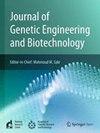利用免疫信息学和反向疫苗学方法确定星状病毒MLB1多表位疫苗模型的优先级
IF 2.8
Q3 Biochemistry, Genetics and Molecular Biology
Journal of Genetic Engineering and Biotechnology
Pub Date : 2024-12-16
DOI:10.1016/j.jgeb.2024.100451
引用次数: 0
摘要
星状病毒MLB1 (HAstV-MLB1)是引起急性胃肠炎感染的非包膜RNA病毒。尽管对HAstV-MLB1的感染和发病机制的研究取得了进展,但目前还没有开发出有效对抗该病原体的疫苗。目前的研究是基于免疫信息学和反向疫苗学方法来设计针对HAstV-MLB1的下一代多表位疫苗模型。我们检索了HAstV-MLB1菌株的全基因组全蛋白质组数据,并进行了一系列分析,以寻找具有显著抗原性且无毒性和致敏性的有效B细胞和t细胞表位。将B细胞和t细胞抗原表位与不同的连接物和佐剂序列结合,设计了一套疫苗构建体。通过严格的理化性质、抗原性、与HLA和TLR4免疫受体的分子对接等标准对模型疫苗结构进行分析,以确保其有效性和安全性。基于β-definsin佐剂对HLA受体的最低结合能为−82.48 kcal/mol,优先进行分子动力学和免疫模拟分析,以评估其稳定性和免疫原性潜力。这些分析表明,MLB1-C2结构具有可行的分子稳定性和增强宿主细胞强免疫反应的潜力。此外,该模型被预测为无毒,非过敏性和抗原性,确保广泛的人群覆盖,并能够引发强大的免疫反应。结果表明,MLB1-C2构建体在大肠杆菌商业重组载体分子中具有潜在的基因表达潜力。目前的研究结果为开发先进的下一代有效的HAstV-MLB1疫苗提供了一个重要的模板。本文章由计算机程序翻译,如有差异,请以英文原文为准。

Multi-epitope-based vaccine models prioritization against Astrovirus MLB1 using immunoinformatics and reverse vaccinology approaches
Astrovirus MLB1 (HAstV-MLB1) is non-enveloped RNA virus that cause acute gastroenteritis infection. Despite research progress about infection and pathogenesis of HAstV-MLB1, Currently, no vaccine has been developed to effectively combat this pathogen. The current study is based on immunoinformatics and reverse vaccinology approaches to design next-generation, multi-epitope-based vaccine models against HAstV-MLB1. Genome-wide whole proteome data of HAstV-MLB1 strain was retrieved, and a series of analyses were conducted to explore effective B and T-cell epitopes that hold significant antigenic nature with no toxicity and allergenicity. A set of vaccine constructs were designed by different combination of lead B and T-cell epitopes with diverse linkers and adjuvants sequences. The model vaccine structures were analyzed via rigorous criteria of physiochemical properties, antigenicity, and molecular docking with HLA and TLR4 immune receptors to ensure their efficacy and safety. Based on the lowest binding energy of −82.48 kcal/mol against the HLA receptor, the MLB1-C2 vaccine model with β-definsin adjuvant was prioritized for molecular dynamic and immune simulations analyses to assess its stability and immunogenic potential. These analyses revealed that the MLB1-C2 construct has feasible molecular stability and potential to boost strong immune responses in the host cell. Besides, the model was predicted to be non-toxic, non-allergenic, and antigenic, ensuring broad population coverage and capable to elicit a robust immune response. The in-silico cloning analysis highlighted a possible gene expression potential of the MLB1-C2 construct in E.coli commercial recombinant vector molecule. The findings of the current study provide an essential template for the development of a advanced next-generation effective vaccine against HAstV-MLB1.
求助全文
通过发布文献求助,成功后即可免费获取论文全文。
去求助
来源期刊

Journal of Genetic Engineering and Biotechnology
Biochemistry, Genetics and Molecular Biology-Biotechnology
CiteScore
5.70
自引率
5.70%
发文量
159
审稿时长
16 weeks
期刊介绍:
Journal of genetic engineering and biotechnology is devoted to rapid publication of full-length research papers that leads to significant contribution in advancing knowledge in genetic engineering and biotechnology and provide novel perspectives in this research area. JGEB includes all major themes related to genetic engineering and recombinant DNA. The area of interest of JGEB includes but not restricted to: •Plant genetics •Animal genetics •Bacterial enzymes •Agricultural Biotechnology, •Biochemistry, •Biophysics, •Bioinformatics, •Environmental Biotechnology, •Industrial Biotechnology, •Microbial biotechnology, •Medical Biotechnology, •Bioenergy, Biosafety, •Biosecurity, •Bioethics, •GMOS, •Genomic, •Proteomic JGEB accepts
 求助内容:
求助内容: 应助结果提醒方式:
应助结果提醒方式:


